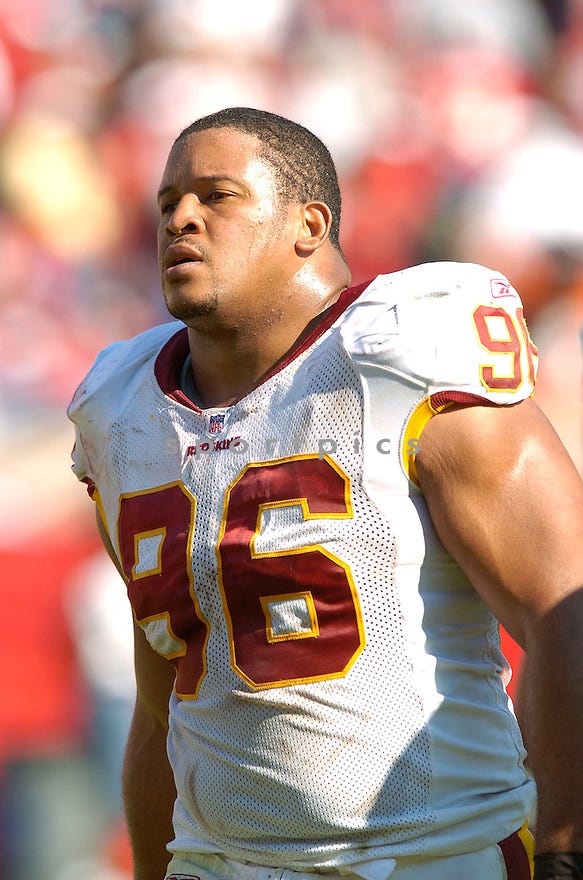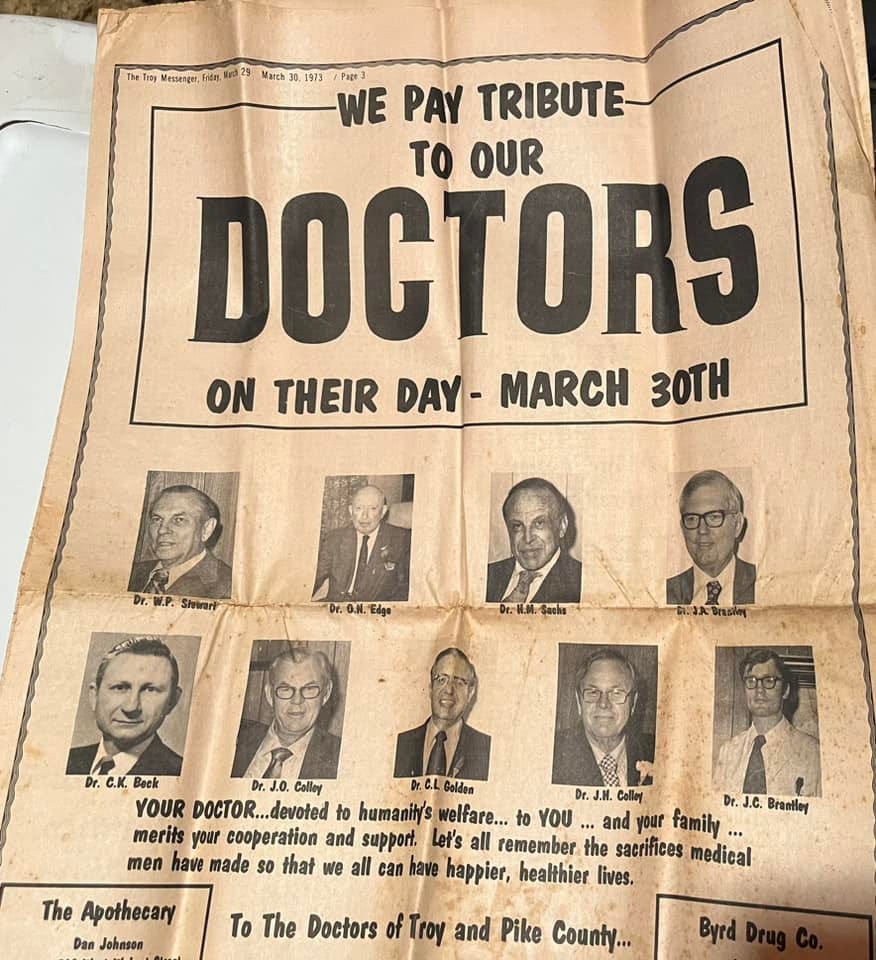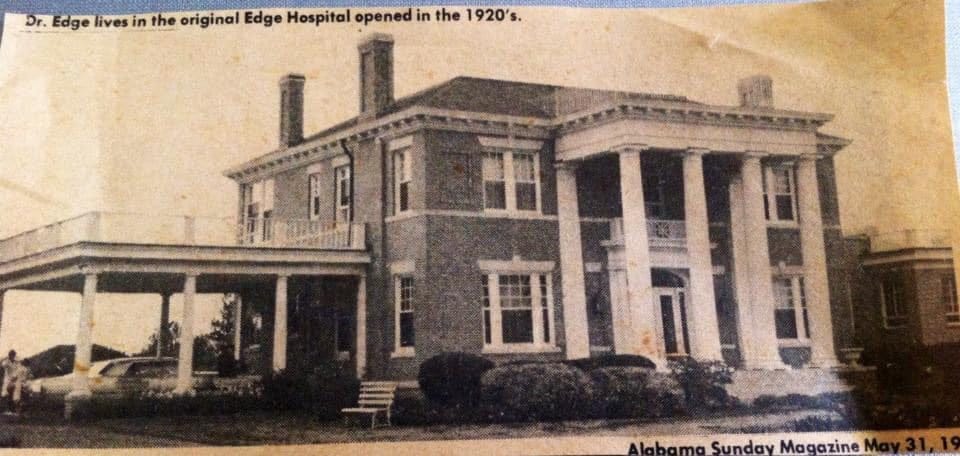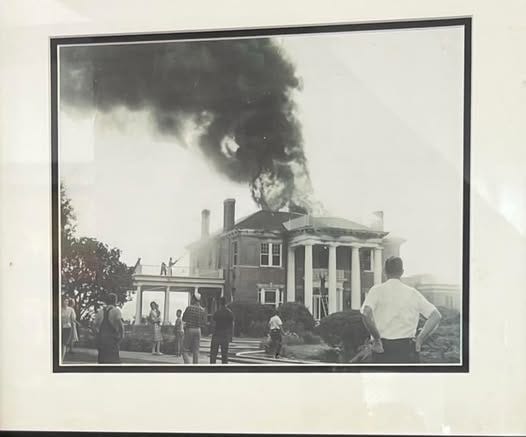Cornelius Griffin was THE key leader at UA …
And other UA & AU greats from Pike County + photos and text about Dr. O. N. Edge and his famous house … AISA’s Troy Triple header and Joe Vann’s Texaco Station.
Editor’s note: Today, I’m sticking to local history stories and found what, I hope, is some Grade-A copy. The first article, which I wrote, appeared in the September 2001 edition of Pike’s Peek.
****

A recent Dothan Eagle story on the Alabama football team confirmed what I’ve written in this space before.
Namely, that Alabama’s football woes began when the eligibility of Brundidge’s Cornelius Griffin expired.
Eagle sports writer Lance Griffin interviewed Alabama center Alonzo Ephraim. The subject of the story deals with the apparent lack of leaders on the Tide’s teams of the past two seasons.
Ephraim, a junior, talked about the athletic and leadership contributions of departed All-Americans Shaun Alexander and Chris Samuels. But he said the 1999 SEC championship team’s most important leader was Griffin.
“Cornelius Griffin was was one of the greatest leaders I’ve ever been around,” said Ephraim. “Just the way he was, the way he carried himself, everybody wanted to go out there and play their hardest.”
“Sometimes, he didn’t even have to say a word. He would just look at you and you would know he thought you weren’t giving it everything you had. It made you want to play that much harder. He just couldn’t stand to lose.”
Since pounding Florida in the championship game in 1999 (Cornelius’s next-to-last game at Bama), the Tide has won a mere six games out of its last 19.
It might be another decade before Alabama wins another SEC title and, according to Ephraim and other Tide players who should know, the man most responsible for Bama’s last title was Brundidge’s own Cornelius Griffin.
Today, Griffin (who was drafted in the second round) is a starter for the New York Giants, where he leads the team’s defensive linemen in tackles. Clearly, the Giants gain was Bama’s loss.
More memories about Cornelius …
Update: I remember watching Cornelius in high school, where he played tight end and defensive end for Coach Wayne Grant’s Bulldogs. (The first time I saw Cornelius up close at a practice his senior year, I thought, “My Gosh. This looks like an NFL player right now!”)
Cornelius had committed to Auburn, but attended junior college for two years to become academically eligible.
After a standout career at Pearl River Junior College, Cornelius changed his college choice to Alabama, probably because he wanted to follow his first cousin, Quincy Jackson, another PCHS product who started off at junior college.
Quincy, who had a stellar career at East Mississippi Junior College (where he is a member of the school’s Sports Hall of Fame), went to Alabama - where he quickly became Alabama’s top receiver. His cousin followed him a year later. The two former Bulldogs played one season, 1998, together in Tuscaloosa.
In his second season in Tuscaloosa playing for Coach Mike DuBose, Cornelius was voted one of Alabama’s team captains, made first-team All SEC and today has his footprints and hand prints etched in the concrete beneath Denny Chimes with other Alabama greats.
Cornelius, who became the only athlete from Pike County to play in a Super Bowl for the Giants, concluded his 10-year NFL career with the Washington Redskins. He finished his career with 460 combined tackles and 29 sacks.
How could a town of 2,000 produce so many great athletes?
It’s interesting to me that Brundidge (population 2,000) and Pike County High School have produced far more impact college players at Alabama and Auburn than nearby and much larger Troy.
In addition to Cornelius and Quincy, tight end Nick Walker also started for three years at Alabama and was a key offensive performer in Nick Saban’s break-out season of 2008.
In the mid-1980s, Steven Wilson lettered several years as a free safety for Alabama.
Remembering Randy Walls …
Brundidge products who had outstanding careers at Auburn included quarterback Randy Walls, who led the 1972 “Amazing’s” to a 10-1 season, No. 5 national finish, and one of the greatest Iron Bowl upset victories ever (“Punt Bama Punt.”)
On a personal note, my father-in-law, Frank Fryer, was a teammate of Walls in three PCHS sports and was on the receiving end of many Walls’ passes (so I’ve heard many “Randy Walls’ stories.”)
Tight end Fred Baxter started multiple years at Auburn and became team captain before having a 10-year NFL career. Baxter also played baseball at Auburn.
The only two Pike County natives to play regular season games in the NFL are Baxter and Cornelius Griffin. Quincy Jackson, who played pre-season games for the Cincinnati Bengals, became a standout in the Arena Football League and Canadian football League).
As far as I am aware, my late father Bill Rice, Sr. was the last Troy native who became a starter at Alabama. (Dad played from 1959-1961, meaning no Troy player has started games at Alabama in the ensuing 63 years).
The last Troy native to start at Auburn was CHHS graduate Zac Etheridge, who was a key defensive player and a team captain on Auburn’s 2010 national championship team.
Etheridge, who played for Hugh Fountain at CHHS, coached defensive backs at his alma mater for several seasons before joining the staff at Houston prior to this season.
Cencade Pennington, the fastest player to ever come out of Pike County, lettered as a tailback and fullback at Auburn for several years.
Several walk-ons and scholar-shipped players have also played for Alabama and Auburn.
*** (Thank you for sharing Troy Citizen content with others) ***
+++++++++++++++++++++++++++++++++
Remembering the AISA ‘Triple Header’ …
Also from the September 2001 Pike’s Peek:
“For the second consecutive year, Troy and TSU will host the “Triple Treat in Troy,” back-to-back-to-back state title games in all three classifications of the Alabama Independent School Association (AISA).
Last year approximately 7,000 visitors attended the games, making the event one of the largest (if not THE largest) event in Pike County as far as attracting out-of-town visitors to our community …”
A Brundidge native (and former great TSU Trojan) gave this gift to Troy …
John Faircloth - a native of Brundidge who was inducted into the Troy Sports Hall of Fame in 2019 after a stellar career as a football player at Troy State from 1959-1961 - was the long-time director of the AISA and the man who no doubt made it possible that Troy and Troy State could host this AISA Triple Header for many years.
When PLAS won its first-ever state championship in football, the Patriots won this historic title up the road in Memorial Stadium.
Personal Note: I appreciate Mr. Faircloth and the AISA because the original Troy Citizen produced the AISA Triple Header game programs for several years. The AISA Triple Header was a fantastic event for the town of Troy.
AHSAA Basketball Tourneys drew huge crowds
I also remember what a big event the AHSAA High School Basketball Regional Tournaments were. For many years, these games (for all AHSAA athletic classifications, boys and girls teams) were held in Troy with the winning teams advancing to the State Final Four, long held in Tuscaloosa and then Birmingham.
The games probably brought more than 15,000 fans to Troy every year. Troy’s Sartain Hall might have been too small to host this event. I remember a memorable game where a highly-touted team from Jeff Davis High School played and the fire marshall had to turn fans away (Sartain had a capacity of about 3,000 fans).
The Region Tournaments, which required tremendous support from Troy State employees, were eventually moved to larger arenas, including the Acadome on the campus of Alabama State in Montgomery.
TROY could certainly once again host this event now that our town is home to Trojan Arena, one of the nicest basketball facilities of its size in America. However, I believe that logistical considerations have probably caused Troy officials to eschew making a bid on this tournament.
+++++++++++++++++++++++++++++++++++++++
Since I’ve re-booted The Troy Citizen - and since this publication has a strong emphasis on local history - I’ve spent a lot of time perusing the excellent Facebook Group Page “You Might be From Troy, Alabama.”
I was recently struck by the following photos I found from the archives of this wonderful history resource.
The Dr. O.N. Edge Home…
I’ve recently run several stories where my late father talked about Dr. O.N. Edge, who served as a local physician for more than 60 years (from 1910 to at least 1973).
This made me curious to learn more about Dr. Edge, who lived in one of the most famous homes in Pike County (probably because it had a heated indoor swimming pool).
Per the photos and stories I found, Dr. Edge’s house (which was located at the current location of Burger King) had once been his privately-operated hospital in the 1920s.
Dr. Edge - perhaps in 1939, according to one Facebook poster - later moved his hospital to downtown - on Academy Street near the current City Hall building and the original location of the Troy Normal School campus.
The Edge Hospital had previously been a female dormitory when the Troy Normal Campus was still located downtown.
Decades later, Dr. Edge’s home was razed to make room for Burger King. I was a child and not living in Troy when a major fire broke out at Dr. Edge’s home. (Maybe readers can help provide more details of what must have been a memorable local event).
I do know from Dad’s history that a milestone event in Troy occurred in the early 1970s when Dr. Edge and the owners of the town’s other hospital, Beard Hospital, closed both hospitals, paving the way for construction of Troy’s current hospital on Highway 231.
Beard Hospital was located on the corner of Walnut and Pine Streets.
Troy’s “new” hospital was known for decades as Edge Memorial Hospital and then Edge Regional Medical Center.
Hill-Burton funds were used to build the consolidated modern healthcare facility, which still serves Pike County today under the name Troy Regional Medical Center.
Child of a farmer becomes county’s leading physician …
From my research, I learned Dr. Edge grew up on a farm in rural Pike County before leaving home for the first time to study medicine at Atlanta’s Emory University. He then returned to Pike County where he practiced medicine for six-plus decades.
For years, Dr. Edge made his rounds in a horse-and-buggy. The first operation he performed was on a dining room table in a house in Montgomery.
Dr. Edge was able to practice medicine into his 80s because he took care of his own health.
According to my research, he used his indoor pool to swim laps every day and only drank alcohol one time in his life (disappointing his mother so much, he quit forever). He also didn’t drink coffee or sodas.
Per multiple stories, Dr. Edge never worried much about patients who were unable to pay him. Many patients would pay in “trade” with food or livestock from their own farms. If someone he treated got better, that was wonderful and sufficient payment for him, said Dr. Edge in one interview.
I couldn’t save one photo of the downtown Edge Hospital. However, based on this photo, the large building had two wide balconies. Patients who were not in serious condition would convalesce while sitting on rocking chairs on the balconies.
The patients could watch the trains go by and their loved ones could walk to downtown to get any food, beverages or sundries for the patients. Apparently, the thought was that the fresh area was good for the patients.
Troy’s roster of doctors, circa 1973 …
Neal Brantley, an artist who now lives in Montgomery, has a deep interest in the history of his hometown.
Neal provided a photo of a full-page ad that appeared in The Troy Messenger for Physician Appreciation Week. The photo provides readers the names and photos of the physicians who were practicing medicine in Pike County in March 1973.

As one can see, Dr. Edge was still practicing.
I recognized most of the other names, including Neal’s brother (Dr. J.C. “Buddy” Brantley) and his father (Dr. J.A. “Jack" Brantley) as well as … Dr. J.O. “Tip” Colley, Dr. J.H. Colley, Dr. C.K Beck, Dr. C.L. Golden (of Brundidge), Dr. W.P. (William) Stewart and Dr. H.M. Sachs.
Talk about a historic move ….
The patriarch of the Colley family of medical practitioners (future doctors, nurses and veterinarians) moved to Troy in1923 when the Alabama Baptist Children’s Home moved to Troy from Evergreen —in one day (!), increasing the town’s population by 219 children - plus administrators and staffers.
James O Colley, the family patriarch, was the Children Home’s first Troy superintendent.
++++++++++++++++++++++++++++++++++++++
Joe Vann’s Texaco Service Station on N. Three Notch Street
This great photo of this service station interested me because it was located next door to previous home of the original Troy Citizen building (now the offices of Blue Key Properties).

Harriet Gaylard Parr remembers this station very well because it was also next to The Enzor Theater (a building now owned by TB&T and undergoing a major renovation - story to come).
“It was full service when you drove up,” wrote Mrs. Parr. “We attended First Presbyterian Church and walked to Vann’s Service Station between Sunday School and Church for a Coca Cola.
“My daddy was manger of Enzor Theater. There were lighted stars in the ceiling. Box office, big lobby with popcorn, candy, large hallway with carpet and comfy chairs between lobby and auditorium.”
Rebecca Williford Davis remembered that “Betty Lou Paine would have her dance recitals at the Enzor and we would change costumes in the back of the service station.”
Dot Green is old enough to remember the great service Mr. Vann provided customers.
“My granddaddy and I would stop there and get a little gas put in my car. Mr. Vann pumped the gas for you and washed my windshield. That was service,” said Dot.
(Thank you for considering a free or paid subscription to The Troy Citizen, Alabama’s only Substack newspaper.)








I think the edge house caught on fire two different times, i remember standing in the yard of the edge house watching the firefighters fight the fire one time
This is an amazing statistic/anecdote to me. (I pulled this number - 219 - from my Dad's history book on Troy):
"The patriarch of the Colley family of medical practitioners (future doctors, nurses and veterinarians) moved to Troy in1923 when the Alabama Baptist Children’s Home moved to Troy from Evergreen —in one day (!), increasing the town’s population by 219 children - plus administrators and staffers.
James O Colley, the family patriarch, was the Children Home’s first Troy superintendent.
As Dad wrote elsewhere, Troy's permanent population growing by at least 219 citizens (more if you count Mr. Colley's family and other staffers who moved from Evergreen) had to be at least 230 - which was the all-time largest one-day jump in Troy's population in one day!